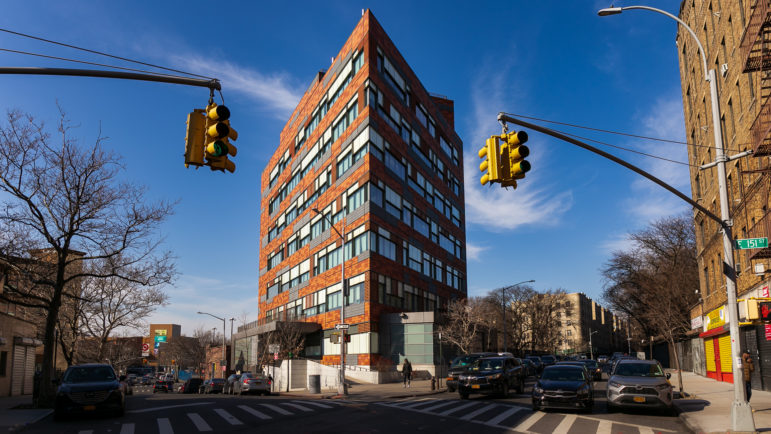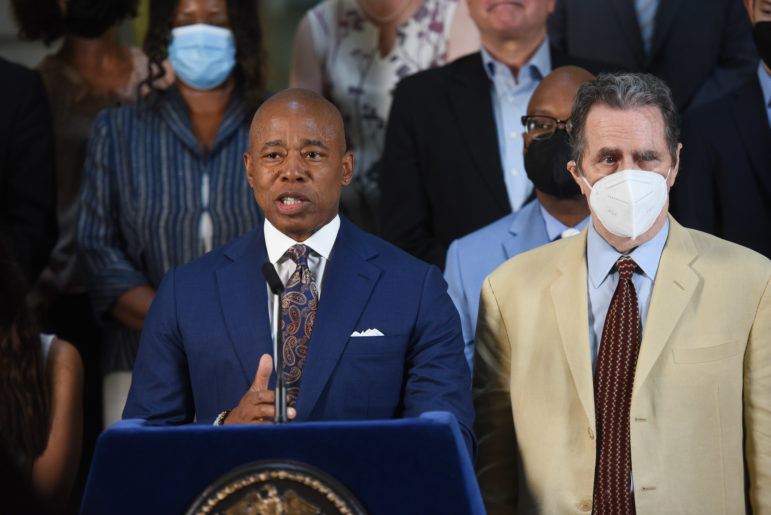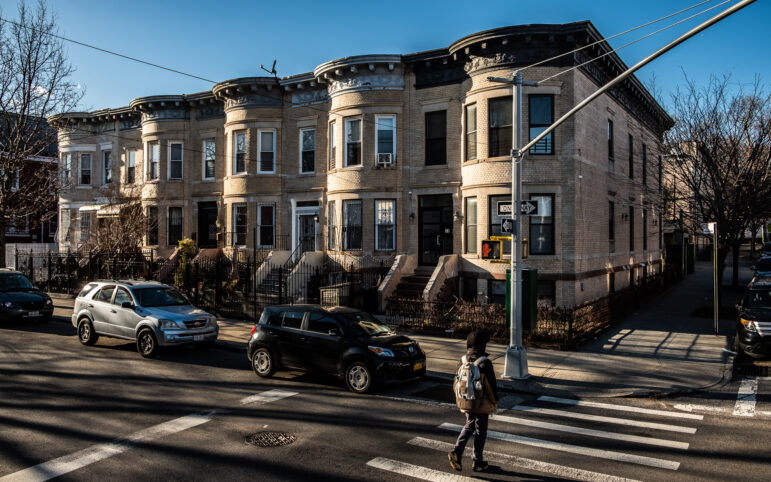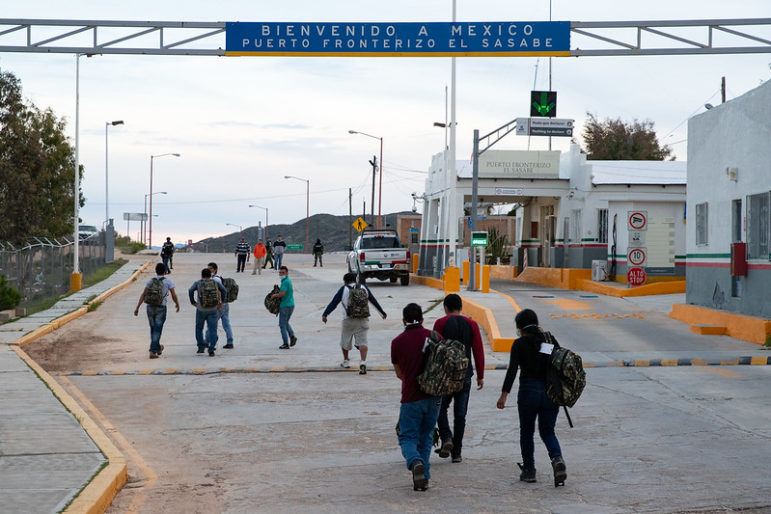For weeks, City Limits has been talking to several Latin American families who entered the city’s shelter system after arriving in the U.S. from southern border states. Mayor Eric Adams has accused Texas and Arizona of sending newly-arrived immigrants to the city, something governors of both states have denied, and the families who spoke with City Limits said they came here with help from nonprofits.

Adi Talwar
Department of Homeless Services’ intake center in the Bronx, the first stop for families entering the city’s shelter system.Lee la versión de español aquí.
With the Chihuahuan desert on the horizon and her two daughters by her side, Glenis imagined the New York City skyline as they trudged through the stifling heat. It was at that moment, she said, that she decided the city would be her family’s final destination.
Their journey had begun in Venezuela in mid-May, with the family slowly moving up through Colombia, Panamá, Costa Rica, Nicaragua, Honduras, Guatemala and México, before finally reaching the U.S. border in Texas in the last week of June.
“New York City was not in our minds” originally, said Glenis, who spoke to a reporter in Spanish and asked not to disclose her last name. “Three hours before crossing the border, we didn’t know where specifically we wanted to go.”
Her husband’s brother’s family had also left Venezuela with Glenis’ family, her brother, and two friends. Others who they met on the long journey by foot told them they could find a spot in New York City’s homeless shelter system. Glenis said they learned from a relative that they could visit the Department of Homeless Services’ family intake center in The Bronx and from there get assigned to a longer-term shelter as they searched for jobs and considered their next move.
When they reached Texas, they were detained by Border Patrol and released a few days later, they said. They then boarded a flight from San Antonio to New York City purchased by a nonprofit group on July 1. With the address of the intake shelter written on a piece of paper, they made their way to The Bronx, with an upcoming immigration court date in New York on the calendar.
Hundreds of other families and individuals who recently crossed the Southern Border have made similar decisions, according to city officials, nonprofit groups and recently arrived immigrants.
On Tuesday morning, New York City Mayor Eric Adams said more than 2,800 Latin American migrants have recently entered the city’s homeless shelter system. At a press conference later in the day, he put the number at “nearly 2,500” in recent months. Over the past two weeks, City Limits has talked with seven such families, all of whom said they flew from a city near the southern border to New York after traveling from Venezuela.
Adams on Tuesday said the rise in newly arrived immigrants has fueled the ongoing increase in the city’s homeless population. The number of people staying in DHS-run shelters surpassed 50,000 at the end of last week, up from 46,591 at the start of the year, according to data tracked by City Limits.
New York City is under court order to provide temporary shelter to anyone experiencing homelessness who visits an intake site, though families must prove they have nowhere else to go―a policy known as right to shelter. But people who arrive in New York City from other places are outliers in the shelter system. Data from 2017 and 2021 obtained by City Limits through Freedom of Information Law requests show that 93 to 96 percent of shelter residents gave a last permanent address within the five boroughs.
The remainder gave either an out-of-city address or a non-verifiable New York City address, DHS notes in the data sheets it provided. Advocates for homeless New Yorkers have disputed the characterization that immigrants are driving the shelter population uptick.
Adams was adamant Tuesday.
“Currently, New York City is experiencing a marked increase in the number of asylum-seekers who are arriving from Latin America and other regions,” Adams said Tuesday. “In some instances, families are arriving on buses sent by the Texas and Arizona governments, while in other cases, it appears that individuals are being sent by the federal government.”
Adams later said he did not actually know whether the new New Yorkers were sent by other governments. “We need to investigate are they giving them one way tickets? We’re not sure,” he said. “This just got on our radar when we started seeing the high numbers show up.”
When asked for clarification, administration officials did not point to any evidence that those state governments are busing new immigrants to New York City, however. Instead, they said they have relied on self-reporting by individuals entering the shelter system who said they traveled from Texas and Arizona, though not through a specific program operated by a state government.
Each family interviewed by City Limits said they arrived in New York City with the assistance of nonprofit groups who purchased their transportation. City Limits visited the PATH intake shelter on July 5 and spoke to six staffers and four clients seeking shelter or submitting additional information. None said they had heard of an effort by another state to bus migrants to New York City.
Gov. Greg Abbott of Texas and Gov. Doug Ducey of Arizona—anti-immigration hard-liners who have both cracked down on migrants and sent asylum-seekers to Democratic strongholds as a form of political theater—also disputed Adams’ claim. Their offices each told City Limits they have only bused immigrants to Washington D.C.. In a well publicized political ploy, Abbott has sent more than 5,000 migrants to the nation’s capital by bus as a form of protest against President Biden’s immigration policies.
City Limits first reached out to Abbott’s office about the rumored New York City busing on July 6. His spokesperson, Renae Eze, said Texas was “still only busing migrants to Washington, D.C.” Eze on Tuesday again said Texas has not shipped newly arrived immigrants to New York City.
Ducey’s office also disputed Adams’ claim. “Mayor Adams needs to get his facts straight and pay closer attention to what’s really occurring because our nation’s security depends on it,” Ducey said. Like Texas, Arizona is also sending migrants to D.C. in an effort to bring the border “a little closer to home” for Biden, he said.
Nevertheless, Adams’ assertion echoed statements made Sunday by D.C. Mayor Muriel Bowser, who told a TV news interviewer that immigrants bused from Texas were straining the city’s shelter capacity. She urged the federal government to help “prevent people from really being tricked into getting on buses” to the capital.
Like Bowser, Adams said he has requested additional financial support from the federal government, arguing that the city’s shelters are “already overburdened.”

Michael Appleton/Mayoral Photography Office
Mayor Eric Adams at a press briefing Tuesday, where he discussed the asylum seekers in shelter.“New York is willing to show its humanitarian outreach and compassion, but we need to get the resources to go with it,” Adams said at a press briefing Tuesday.
There is no doubt that a significant number of newly arrived immigrant families are entering the New York City DHS shelter system. An official close to DHS said the agency had been trying to identify the cause of the rise at least as early as last month. Shelter staff and administrators interviewed by City Limits have also noted the rise in asylum-seekers and other immigrants without legal authorization, though they said they did not know what was spurring the increase.
City Limits met with some of the families at a donation and at a facility in Manhattan where several immigrants, many of them from Venezuela, have been placed after first entering the PATH shelter. Each described the nonprofits that helped them secure transportation to the five boroughs, which feature a strong social safety net, legal support options and, in some cases, existing family ties.
The nonprofit Miles4Migrants has used frequent flyer miles donated by other travelers to help refugees and asylum-seekers move from locations near the Southern Border to other destinations. The group said they have purchased flights for nearly 4,500 passengers in the first six months of 2022. As of July 15, they have flown a total of 1,269 passengers to the New York City area, they said.
“Over the last few weeks, the Miles4Migrants Booking Team has experienced the highest volume of incoming domestic travel requests that our organization has ever seen,” said Miles4Migrants Co-Founder Andy Freedman.
The people the group has aided most commonly hail from Colombia, Honduras, Venezuela, Haiti and México, Freedman said.
Venezuelans and Immigration Aid (VIA), an organization that supports displaced people and asylum-seekers, said they have been contacted for help by about 3,000 people in New York City. They said 90 percent were immigrants who recently arrived from the U.S. southern border, compared to only 35 percent of those they assisted in 2021.
“We receive people from all Latin American countries, however, the priority is Venezuela, because there are no consular services in the U.S., so Venezuelans are orphans,” explained VIA’s Co-Founder and Co-Director Niurka Meléndez in Spanish over the phone.
The United States does not recognize Venezuelan dictator Nicolás Maduro and has granted the nation’s embassies to an opposition group led by failed coup-leader Juan Guaidó. Venezuela is in the midst of a deep economic crisis under an authoritarian regime. The diplomatic dispute has left Venezuelans in the U.S. without an institution to obtain vital records or receive other support.
A family of three who flew from Houston to New York said they arrived at the intake shelter on July 11 and were transferred to a Manhattan hotel-turned-shelter facility two days later.
“We were told that we will be here for about 10 days,” said one of the family members, a man named Francisco, in Spanish. He said he preferred not to disclose his last name and said his family is being monitored by a cell phone given to him by Immigration and Customs Enforcement (ICE) as part of the Alternatives to Detention program.
Another woman at the hotel on July 15 said she had arrived in the U.S. from Venezuela about two weeks earlier and visited the intake shelter after making her way to New York City three days before. She was then assigned to the Manhattan location and found the site comfortable, she said as she pushed her toddler in a stroller.
After visiting the intake site, Glenis and her children were assigned a single room in a shelter in Brooklyn without a kitchen. Her husband’s brother and his family—two children and their mother— are staying at a shelter in Harlem, where four other families contacted by City Limits are also staying.
The new arrivals mark the latest chapter in New York City’s rich immigrant heritage.
After their often arduous journey up to the five boroughs, the Latin American immigrants in city homeless shelters face another hurdle: finding permanent housing. While New York City has the nation’s most expansive social safety net, non-citizens without legal status do not qualify for most rental assistance programs that enable low-income residents to secure an apartment. That can leave some undocumented immigrants stuck in shelter indefinitely.
“Mayor Adams and Governor Hochul should ensure that subsidies are available to as broad a range of New Yorkers as possible— without restrictions based on immigration status or the specific agencies serving them,” the Coalition for the Homeless wrote in its most recent annual report.
The city is also mired in a deep affordable housing shortage that forces many low-income renters, particularly immigrants, to share tight living quarters, as in the case of Glenis’ family. A 2021 report by the Mayor’s Office of Immigrant Affairs (MOIA) determined that a third of undocumented immigrants live in overcrowded households—defined as one person per room—compared to less than 15 percent among U.S. citizens. About 21 percent of all immigrant New Yorkers live in overcrowded households, including about 8 percent who live in “extremely overcrowded” housing with more than 1.5 people per room.
All of the adults in the families contacted by City Limits said they are actively looking for work, and none of them think of the shelter system as the final destination of their journey, but rather as a stepping stone. Though many said they have not received guidance on where to go to find a job, some of these families are already venturing out to take the first opportunities they find.
Following Adams’ remarks, homeless rights advocates blasted what they saw as a cynical attempt to blame the rising shelter census on immigrants.
“Let’s be clear: the growing shelter census crisis squarely falls at the Mayor’s feet, and asylum-seekers shouldn’t shoulder the blame for this,” said the Legal Aid Society and the Coalition for the Homeless in a joint statement Tuesday.
The Coalition for the Homeless provides support for undocumented immigrants experiencing homelessness through its Crisis Intervention Program, as do various other New York City-based nonprofits. In addition to DHS, homeless immigrants in New York can seek resources through the MOIA.
A series of executive orders also forbids city agencies, including DHS, from sharing residency status information with federal immigration authorities. Various nonprofit legal groups provide free representation in immigration court, increasing the odds that applicants win their asylum cases or obtain legal status.
Less than a month after arriving in the U.S., Glenis and her family are eager to get out of the shelter and into an apartment in the city where they have made a fresh start.
At a clothing donation event on July 9, Glenis, her husband and her children reunited with her brother-in-law and his family following their separation at the border. The two men have already managed to land jobs, though they only earn $12 an hour.
Glenis knows that to move out of the shelter she has to find a job, too.
“I don’t see myself there in the long term,” she said by phone Tuesday morning.
She said she and her family are also sticking together and staying vigilant against potential scammers.
“As in every country, until you know how things work, people are going to want to take advantage of you,” she said.
With additional reporting by Jeanmarie Evelly









2 thoughts on “Who Are The Families Entering NYC Shelters From the Southern Border? ”
As a descended of immigrants who came to the United States at various ages, I do hope that the Venezuelan people find their way through the maze of confusion in the city. Venezuelan people are very hard-working people. I’m sure they will make a great contribution to the city of New York.
Many South American people are very hard working people. As a descendant of immigrants who came to the United States at various ages, I have first time knowledge about the hardships that they go through, and how hard they work. Sometimes they work 12 10 hours a day. New York should welcome these immigrants, since they will improve the economy of the city. They’re basically hard working people who had an unfortunate experience in their country that caused them to leave.